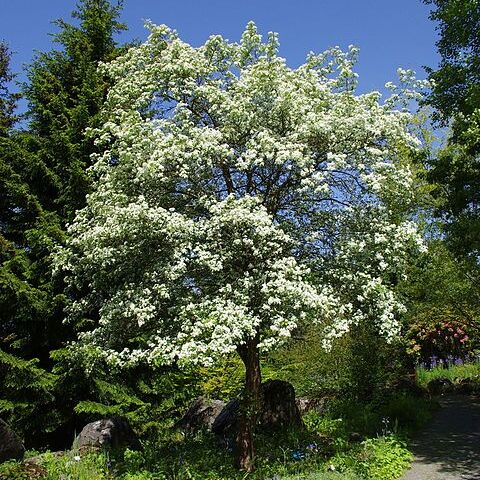Shrubs or small trees, to 7 m tall, unarmed or armed; thorns 1.5–3.5 cm. Branchlets purplish brown, terete, initially densely white pubescent, glabrescent; buds purplish brown, ovoid, glabrous. Stipules caducous, falcate, 5–8 mm, membranous, subglabrous, margin glandular serrate, apex acute or acuminate; petiole 1.5–2.5 cm, sparsely villous; leaf blade broadly ovate or rhombic-ovate, 4–6 × 3.5 cm, abaxially densely whitish villous, adaxially sparsely pubescent, base cuneate or broadly cuneate, occasionally truncate, margin remotely doubly serrate and with 3–5 pairs of lobes, apex acute. Compound corymb 4–5 cm in diam., many flowered; peduncle whitish villous; bracts caducous, linear-lanceolate, membranous. Pedicel 3–8 mm, whitish villous. Flowers ca. 1.2 cm in diam. Hypanthium campanulate, abaxially white pubescent. Sepals triangular-ovate or triangular-lanceolate, 3–4 mm, abaxially white pubescent. Petals white, suborbicular, ca. 5 mm. Stamens 20. Styles (2 or)3–5, pubescent basally. Pome purplish brown or red, globose, ca. 8 mm in diam., initially pubescent, later glabrous; fruiting pedicel 4–9 mm, initially densely white villous, glabrate when mature; sepals persistent, reflexed; pyrenes 3–5, with concave scars on both inner sides. Fl. May–Jun, fr. Aug–Sep. 2n = 32, 34*, 51*.
More
A shrub or small tree. It loses its leaves during the year. It grows 7 n high. It is hairy. There are thorns up to 3.5 cm long. The young branches are purplish-brown. The leaves are oval and 4-8 cm long by 3-6 cm wide. They are rounded at the base. There are shallow lobes along the sides. There are teeth along the edge. The flowers are white and 1.2 cm across. The fruit are oblong and 8-10 mm across.
Riverain deciduous forest strips, crests, meadows of flooded valleys, forest edges and dry mountain slopes. Near or in mixed forests, roadsides, river sides; at elevations from 200-1,000 metres.
More
Temperate. It is native to northern China. It grows between 200-1,000 m above sea level.

